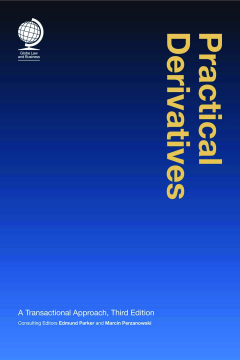
Additional Information
Book Details
Abstract
Since the near-collapse of the global financial system back in 2008, the derivatives industry has come a long way. As derivatives were blamed for causing, or contributing to, the crisis, the politicians and regulators on both side of the Atlantic (and in most other developed jurisdictions) decided to take action. In September 2009 the G20 leaders at their meeting in Pittsburg resolved the following: “All standardised OTC derivative contracts should be traded on exchanges or electronic trading platforms, where appropriate, and cleared through central counterparties by the end of 2012 at the latest.” Even though it is now 2016, the regulators continue to work on the detailed rules, which still won’t be fully implemented for a while. Nonetheless, the derivatives markets have already changed almost beyond recognition, and continue to evolve.
Featuring updated chapters, this third edition of Practical Derivatives: A Transactional Approach shows how derivatives are used in a variety of transactions, how the documentation works, and why boards need to be aware of the derivatives market. It also analyses the impact of the recent regulatory changes on derivatives transactions and related documentation.
This latest edition includes chapters on established markets such as equity and energy derivatives, but it also discusses the expansion of derivatives into new markets such as credit risk, weather risk and property. It features topical analysis on corporate governance and directors' duties; it includes an overview of the documentation produced by the International Swaps and Derivatives Association, the International Capital Markets Association and the German banking association; and it discusses related issues such as close-out netting. This edition would not be complete without an analysis of the recent derivatives regulation, and the transactional documentation that helps to implement the new rules.
Table of Contents
| Section Title | Page | Action | Price |
|---|---|---|---|
| Front cover\r | 1 | ||
| Title\r | 2 | ||
| Copyright | 3 | ||
| Table of contents\r | 4 | ||
| Preface Edmund Parker Marcin Perzanowski Mayer Brown | 6 | ||
| Corporate governance and derivatives end users Paul Ali University of Melbourne | 8 | ||
| Regulation of OTC derivatives Ruth Frederick Senior legal counsel | 26 | ||
| Close-out netting Kunel Tanna Mayer Brown | 80 | ||
| Overview of industry standard documentation Guy Usher Fieldfisher | 106 | ||
| Introduction to German derivatives documentation Patrick Scholl Mayer Brown | 126 | ||
| Documentation for cleared OTC derivatives Patrick Scholl Mayer Brown | 138 | ||
| Designing derivatives structures John D Finnerty Rachael W Park AlixPartners LLP | 156 | ||
| Introduction to commodity derivatives Edmund Parker Marcin Perzanowski Mayer Brown | 178 | ||
| Overview of the 2005 ISDA Commodity Definitions Edmund Parker Marcin Perzanowski Mayer Brown | 206 | ||
| Emissions trading Edmund Parker Mayer Brown | 252 | ||
| Weather derivatives Paul O Oranika Africa Business World | 280 | ||
| Energy derivatives and hedging strategies Christopher Clancy Cyriel de Jong KYOS Energy Consulting | 290 | ||
| Introduction to equity derivatives Edmund Parker Marcin Perzanowski Mayer Brown | 304 | ||
| Overview of the 2002 ISDA Equity Derivatives Definitions Edmund Parker Marcin Perzanowski Mayer Brown | 340 | ||
| Introduction to credit derivatives Edmund Parker Mayer Brown | 410 | ||
| Overview of the 2014 ISDA Credit Derivatives Definitions Edmund Parker Mayer Brown | 454 | ||
| Interest rate derivatives Natalie Ashford Vincent KP Sum Mayer Brown | 528 | ||
| FX derivatives David Johnson First Abu Dhabi Bank PJSC | 538 | ||
| Property derivatives Edmund Parker Mayer Brown Emmett Peters Addleshaw Goddard LLP | 566 | ||
| About the authors | 590 |
